東大塾長の山田です。
このページでは、「ルートの分数の有理化のやり方」について解説します。
「有理化の基本」から、「複雑な分数の有理化」まで、例題を解きながら丁寧に分かりやすく解説していきます。
「基本的なことはわかってる!」という方は、「3. 分母の項が2つの場合の有理化のやり方」、
あるいは、「4. 分母の項が3つの場合の有理化のやり方」からご覧ください。
それでは、この記事を最後まで読んで、「有理化のやり方」をマスターしてください!
1. 有理化とは?
まずは、「有理化とは何か?」ということについて、確認しておきましょう。
分母に根号(ルート)を含む式を、分母に根号(ルート)を含まない形に変形することを、分母の有理化といいます。
\( \displaystyle \large{ \frac{1}{\sqrt{2}} \Longrightarrow \frac{\sqrt{2}}{2} } \)
「分母の無理数(ルート)を有理数に変形すること」なので、「分母の有理化」というわけです。
2. 有理化のやり方(基本)
それでは、有理化のやり方を解説していきます。
2.1 有理化のやり方基本3ステップ
有理化のやり方の基本は、次の3つの手順でやっていきます。
- ルートの中を簡単にし、約分する
- 分母にあるルートを、分母・分子に掛ける
- 分子のルートを簡単にし、約分する
具体的に問題を使って解説していきましょう。
2.2 【例題①】\( \frac{2}{\sqrt{3}} \)
次の式を、分母を有理化して簡単にせよ。
\( \displaystyle \frac{2}{\sqrt{3}} \)
この問題は「① ルートの中を簡単にし、約分する」は該当しないので、
「② 分母にあるルートを、分母・分子に掛ける」からいきます。
分母に \( \sqrt{3} \) があるので、分母・分子に \( \sqrt{3} \) を掛けます。
\( \begin{align}
\displaystyle \frac{2}{\sqrt{3}} & = \frac{2}{\sqrt{3}} \color{blue}{ \times \frac{\sqrt{3}}{\sqrt{3}} } \\
\\
& = \frac{2\sqrt{3}}{3}
\end{align} \)
すると、分母にルートがない形になったので、完了です。
\( \displaystyle \frac{2}{\sqrt{3}} = \frac{2}{\sqrt{3}} \times \frac{\sqrt{3}}{\sqrt{3}} = \frac{2\sqrt{3}}{3} \)
2.3 【例題②】\( \frac{10}{\sqrt{5}} \)
次の式を、分母を有理化して簡単にせよ。
\( \displaystyle \frac{10}{\sqrt{5}} \)
今回も「② 分母にあるルートを、分母・分子に掛ける」から出発します。
分母に\( \sqrt{5} \) があるので、分母・分子に \( \sqrt{5} \) を掛けます。
\( \begin{align}
\displaystyle \frac{10}{\sqrt{5}} & = \frac{10}{\sqrt{5}} \color{blue}{ \times \frac{\sqrt{5}}{\sqrt{5}} } \\
\\
& = \frac{10\sqrt{5}}{5}
\end{align} \)
分母にルートがない形になりました。
でも!ここで注意です!!
今回は、「③ 分子のルートを簡単にし、約分する」ができます。
\( \begin{align}
\displaystyle & = \frac{10\sqrt{5}}{5} \\
\\
& = 2\sqrt{5}
\end{align} \)
これで有理化完了です。
解答をまとめます。
\( \begin{align}
\displaystyle \color{red}{ \frac{10}{\sqrt{5}} } & = \frac{10}{\sqrt{5}} \times \frac{\sqrt{5}}{\sqrt{5}} \\
\\
& = \frac{10\sqrt{5}}{5} \\
\\
& \color{red}{ = 2\sqrt{5} \cdots 【答】 }
\end{align} \)
2.4 【例題③】\( \frac{\sqrt{2}}{\sqrt{7}} \)
次の式を、分母を有理化して簡単にせよ。
\( \displaystyle \frac{\sqrt{2}}{\sqrt{7}} \)
今回の問題では、分子にもルートがありますね。
でも、関係ありません。
分母・分子に\( \sqrt{7} \)を掛けます。
\( \begin{align}
\displaystyle \frac{\sqrt{2}}{\sqrt{7}} & = \frac{\sqrt{2}}{\sqrt{7}} \color{blue}{ \times \frac{\sqrt{7}}{\sqrt{7}} } \\
\\
& = \frac{\sqrt{14}}{7}
\end{align} \)
分母にルートがない形になったので、これで有理化完了です。
\( \begin{align}
\displaystyle \color{red}{ \frac{\sqrt{2}}{\sqrt{7}} } & = \frac{\sqrt{2}}{\sqrt{7}} \times \frac{\sqrt{7}}{\sqrt{7}} \\
\\
& \color{red}{ = \frac{\sqrt{14}}{7} \cdots 【答】 }
\end{align} \)
2.5 【例題④】\( \frac{8}{\sqrt{18}} \)
次の式を、分母を有理化して簡単にせよ。
\( \displaystyle \frac{8}{\sqrt{18}} \)
今回の問題では、「① ルートの中を簡単にし、約分する」が登場です。
分母の \( \sqrt{18} \) を先に簡単にしてから有理化すると、楽に計算ができます。
まずは、\( \sqrt{18} \)を先に簡単にします。
\( \displaystyle \frac{8}{\sqrt{18}} = \frac{8}{3\sqrt{2}} \)
ルートの中を簡単にしたので、有理化をします。
分母が \( 3\sqrt{2} \) ですが、掛けるのはルートの部分、
つまり、\( \sqrt{2} \) だけ掛ければOKです。
\( \begin{align}
\displaystyle \frac{8}{\sqrt{18}} & = \frac{8}{3\sqrt{2}} \\
\\
& = \frac{8}{3\sqrt{2}} \color{blue}{ \times \frac{\sqrt{2}}{\sqrt{2}} } \\
\\
& = \frac{8\sqrt{2}}{3 \times 2} \\
\\
& = \frac{8\sqrt{2}}{6}
\end{align} \)
有理化が完了しましたが、今回も約分ができるので、注意が必要です。
\( \begin{align}
\displaystyle & = \frac{8\sqrt{2}}{6} \\
\\
& = \frac{4\sqrt{2}}{3}
\end{align} \)
これで、解となります。
解答をまとめます。
\( \begin{align}
\displaystyle \color{red}{ \frac{8}{\sqrt{18}} } & = \frac{8}{3\sqrt{2}} \\
\\
& = \frac{8}{3\sqrt{2}} \times \frac{\sqrt{2}}{\sqrt{2}} \\
\\
& = \frac{8\sqrt{2}}{3 \times 2} \\
\\
& = \frac{8\sqrt{2}}{6} \\
\\
& \color{red}{ = \frac{4\sqrt{2}}{3} }
\end{align} \)
2.6 【例題⑤】\( \frac{\sqrt{15}-4}{\sqrt{3}} \)
次の式を、分母を有理化して簡単にせよ。
\( \displaystyle \frac{\sqrt{15}-4}{\sqrt{3}} \)
今回の問題では、分子の項が2つあります。
このような場合でも、これまで通りのやり方で有理化すればOKです。
分母・分子に \( \sqrt{3} \) を掛けます。
\( \begin{align}
\displaystyle \frac{\sqrt{15}-4}{\sqrt{3}} & = \frac{\sqrt{15}-4}{\sqrt{3}} \color{blue}{ \times \frac{\sqrt{3}}{\sqrt{3}} } \\
\\
& = \frac{\sqrt{45}-4\sqrt{3}}{3}
\end{align} \)
ここで、分子の\( \sqrt{45} \)が、「③ 分子のルートを簡単にし、約分する」ができます。
\( \begin{align}
\displaystyle & = \frac{\sqrt{45}-4\sqrt{3}}{3} \\
\\
& = \frac{3\sqrt{5}-4\sqrt{3}}{3}
\end{align} \)
これで完了です。
解答をまとめます。
\( \begin{align}
\displaystyle \color{red}{ \frac{\sqrt{15}-4}{\sqrt{3}} } & = \frac{\sqrt{15}-4}{\sqrt{3}} \times \frac{\sqrt{3}}{\sqrt{3}} \\
\\
& = \frac{\sqrt{45}-4\sqrt{3}}{3} \\
\\
& \color{red}{ = \frac{3\sqrt{5}-4\sqrt{3}}{3} }
\end{align} \)
\( \displaystyle \frac{b}{k\sqrt{a}} = \frac{b}{k\sqrt{a}} \color{red}{ \times \frac{\sqrt{a}}{\sqrt{a}} } = \frac{b\sqrt{a}}{ka} \)
3. 分母の項が2つのときの有理化
次は、「分母の項が2つのときの有理化のやり方」を解説します。
3.1 分母の項が2つのときの有理化のやり方
分母の項が2つの式では、乗法公式の和と差の積
\( \displaystyle \large{ (a+b)(a-b) = a^2-b^2 } \)
を用いて、有理化をします。
\( \begin{align}
\displaystyle & (\sqrt{a}+\sqrt{b})(\sqrt{a}-\sqrt{b}) \\
\\
= & (\sqrt{a})^2-(\sqrt{b})^2 \\
\\
= & a-b
\end{align} \)
といった具合に、乗法公式の和と差の積を用いると、各項が2乗され、ルートを取り払うことができます。
\( \begin{align}
\displaystyle ① \ \ & \frac{c}{\sqrt{a}+\sqrt{b}} \\
\\
& = \frac{c}{\sqrt{a}+\sqrt{b}} \color{red}{ \times \frac{(\sqrt{a}-\sqrt{b})}{(\sqrt{a}-\sqrt{b})} } \\
\\
& = \frac{c (\sqrt{a}-\sqrt{b})}{a-b} \\
\end{align} \)
\( \begin{align}
\displaystyle ② \ \ & \frac{c}{\sqrt{a}-\sqrt{b}} \\
\\
& = \frac{c}{\sqrt{a}-\sqrt{b}} \color{red}{ \times \frac{(\sqrt{a}+\sqrt{b})}{(\sqrt{a}+\sqrt{b})} } \\
\\
& = \frac{c (\sqrt{a}+\sqrt{b})}{a-b} \\
\end{align} \)
具体的に問題を使って解説していきましょう。
3.2 【例題⑥】\( \frac{1}{\sqrt{3}+2} \)
次の式を、分母を有理化して簡単にせよ。
\( \displaystyle \frac{1}{\sqrt{3}+2} \)
分母が \( \sqrt{3}+2 \) なので、和と差の積の形になるように、分母・分子に \( (\sqrt{3}-2) \) を掛けます。
\( \begin{align}
\displaystyle \color{red}{ \frac{1}{\sqrt{3}+2} } & = \frac{1}{\sqrt{3}+2} \color{blue}{ \times \frac{\sqrt{3}-2}{\sqrt{3}-2} } \\
\\
& = \frac{\sqrt{3}-2}{(\sqrt{3})^2-2^2} \\
\\
& = \frac{\sqrt{3}-2}{3-4} \\
\\
& = \frac{\sqrt{3}-2}{-1} \\
\\
& \color{red}{ = -\sqrt{3}+2 }
\end{align} \)
すると、分母にルートがない形になったので、完了です。
\( \begin{align}
\displaystyle \color{red}{ \frac{1}{\sqrt{3}+2} } & = \frac{1}{\sqrt{3}+2} \times \frac{\sqrt{3}-2}{\sqrt{3}-2} \\
\\
& = \frac{\sqrt{3}-2}{(\sqrt{3})^2-2^2} \\
\\
& = \frac{\sqrt{3}-2}{3-4} \\
\\
& = \frac{\sqrt{3}-2}{-1} \\
\\
& \color{red}{ = -\sqrt{3}+2 \cdots 【答】 }
\end{align} \)
3.3 【例題⑦】\( \frac{\sqrt{3}+\sqrt{2}}{\sqrt{3}-\sqrt{2}} \)
次の式を、分母を有理化して簡単にせよ。
\( \displaystyle \frac{\sqrt{3}+\sqrt{2}}{\sqrt{3}-\sqrt{2}} \)
分子にもルートがあり、少し複雑に見えますが、有理化のやり方は変わりません。
分母が \( \sqrt{3}-\sqrt{2} \) なので、和と差の積の形になるように、分母・分子に \( (\sqrt{3}+\sqrt{2}) \) を掛けます。
\( \begin{align}
\displaystyle \color{red}{ \frac{\sqrt{3}+\sqrt{2}}{\sqrt{3}-\sqrt{2}} } & = \frac{\sqrt{3}+\sqrt{2}}{\sqrt{3}-\sqrt{2}} \color{blue}{ \times \frac{\sqrt{3}+\sqrt{2}}{\sqrt{3}+\sqrt{2}} } \\
\\
& = \frac{(\sqrt{3}+\sqrt{2})^2}{(\sqrt{3})^2-(\sqrt{2})^2} \\
\\
& = \frac{5+2\sqrt{6}}{3-2} \\
\\
& = \frac{5+2\sqrt{6}}{1} \\
\\
& \color{red}{ = 5+2\sqrt{6} }
\end{align} \)
分母にルートがない形になったので、完了です。
\( \begin{align}
\displaystyle \color{red}{ \frac{\sqrt{3}+\sqrt{2}}{\sqrt{3}-\sqrt{2}} } & = \frac{\sqrt{3}+\sqrt{2}}{\sqrt{3}-\sqrt{2}} \times \frac{\sqrt{3}+\sqrt{2}}{\sqrt{3}+\sqrt{2}} \\
\\
& = \frac{(\sqrt{3}+\sqrt{2})^2}{(\sqrt{3})^2-(\sqrt{2})^2} \\
\\
& = \frac{5+2\sqrt{6}}{3-2} \\
\\
& = \frac{5+2\sqrt{6}}{1} \\
\\
& \color{red}{ = 5+2\sqrt{6} \cdots 【答】 }
\end{align} \)
3.4 【例題⑧】\( \frac{2}{5-2\sqrt{6}} \)
次の式を、分母を有理化して簡単にせよ。
\( \displaystyle \frac{2}{5-2\sqrt{6}} \)
今回は、分母のルートに係数があるパターンです。
これもやり方は変わらず、和と差の積になるものを掛けます。
分母が \( 5-2\sqrt{6} \) なので、和と差の積の形になるように、分母・分子に \( (5+2\sqrt{6}) \) を掛けます。
\( \begin{align}
\displaystyle \color{red}{ \frac{2}{5-2\sqrt{6}} } & = \frac{2}{5-2\sqrt{6}} \color{blue}{ \times \frac{5+2\sqrt{6}}{5+2\sqrt{6}} } \\
\\
& = \frac{10+4\sqrt{6}}{5^2-(2\sqrt{6})^2} \\
\\
& = \frac{10+4\sqrt{6}}{25-24} \\
\\
& = \frac{10+4\sqrt{6}}{1} \\
\\
& \color{red}{ = 10+4\sqrt{6} }
\end{align} \)
これで有理化完了です。
\( \begin{align}
\displaystyle \color{red}{ \frac{2}{5-2\sqrt{6}} } & = \frac{2}{5-2\sqrt{6}} \times \frac{5+2\sqrt{6}}{5+2\sqrt{6}} \\
\\
& = \frac{10+4\sqrt{6}}{5^2-(2\sqrt{6})^2} \\
\\
& = \frac{10+4\sqrt{6}}{25-24} \\
\\
& = \frac{10+4\sqrt{6}}{1} \\
\\
& \color{red}{ = 10+4\sqrt{6} \cdots 【答】 }
\end{align} \)
4. 分母の項が3つのときの有理化のやり方
次は、「分母の項が3つのときの有理化のやり方」を解説します。
分母の項が3つのときも、2つのときと同じように、和と差の積を使います!
具体的に問題を使って解説していきましょう。
4.1 【例題⑨】\( \frac{1}{1+\sqrt{2}+\sqrt{3}} \)
次の式を、分母を有理化して簡単にせよ。
\( \displaystyle \frac{1}{1+\sqrt{2}+\sqrt{3}} \)
分母の項が3つのときは、左の2つの項にかっこをつけて1つにまとめて、分母全体で2つの項として考えます。
今回の場合であれば、分母を
\( 1+\sqrt{2}+\sqrt{3} = \color{red}{ (1+\sqrt{2})+\sqrt{3} } \)
と考えて、2つの項として考えます。
これと和と差の積になるようなものは
\( \color{red}{ (1+\sqrt{2})-\sqrt{3} } \)
となります。
これを分母・分子に掛けてあげることで、有理化ができます。
\( \begin{align}
& \frac{1}{ \color{red}{ 1+\sqrt{2}+\sqrt{3} } } \\
\\
= & \frac{1}{ \color{red}{ (1+\sqrt{2})+\sqrt{3} } } \\
\\
= & \frac{1}{(1+\sqrt{2})+\sqrt{3}} \color{blue}{ \times \frac{ (1+\sqrt{2})-\sqrt{3} }{ (1+\sqrt{2})-\sqrt{3} } } \\
\\
= & \frac{1+\sqrt{2}-\sqrt{3}}{(1+\sqrt{2})^2-(\sqrt{3})^2} \\
\\
= & \frac{1+\sqrt{2}-\sqrt{3}}{(1+2\sqrt{2}+2)-3} \\
\\
= & \frac{1+\sqrt{2}-\sqrt{3}}{2\sqrt{2}}
\end{align} \)
これで1段階目が完了です。
あとは、これまでの有理化のやり方をもう一度やります。
分母が \( 2\sqrt{2} \) なので、分母・分子に \( \sqrt{2} \) を掛けます。
\( \begin{align}
\displaystyle & = \frac{1+\sqrt{2}-\sqrt{3}}{2\sqrt{2}} \\
\\
& = \frac{1+\sqrt{2}-\sqrt{3}}{2\sqrt{2}} \color{blue}{ \times \frac{\sqrt{2}}{\sqrt{2}} } (有理化)\\
\\
& = \frac{\sqrt{2} + 2 – \sqrt{6}}{4} \\
\\
& = \frac{2 + \sqrt{2} – \sqrt{6}}{4} (分子を並び替えた)\\
\end{align} \)
これで有理化ができました。
解答をまとめます。
\( \begin{align}
\displaystyle & \color{red}{ \frac{1}{1+\sqrt{2}+\sqrt{3}} } \\
\\
& = \frac{1}{(1+\sqrt{2})+\sqrt{3}} \times \frac{ (1+\sqrt{2})-\sqrt{3} }{ (1+\sqrt{2})-\sqrt{3} } \\
\\
& = \frac{1+\sqrt{2}-\sqrt{3}}{(1+\sqrt{2})^2-(\sqrt{3})^2} \\
\\
& = \frac{1+\sqrt{2}-\sqrt{3}}{(1+2\sqrt{2}+2)-3} \\
\\
& = \frac{1+\sqrt{2}-\sqrt{3}}{2\sqrt{2}} \\
\\
& = \frac{1+\sqrt{2}-\sqrt{3}}{2\sqrt{2}} \times \frac{\sqrt{2}}{\sqrt{2}} \\
\\
& \color{red}{ = \frac{2 + \sqrt{2} – \sqrt{6}}{4} \cdots 【答】 }
\end{align} \)
4.2 【例題⑩】\( \frac{\sqrt{5}-\sqrt{6}+\sqrt{11}}{\sqrt{5}+\sqrt{6}+\sqrt{11}} \)
次の式を、分母を有理化して簡単にせよ。
\( \displaystyle \frac{\sqrt{5}-\sqrt{6}+\sqrt{11}}{\sqrt{5}+\sqrt{6}+\sqrt{11}} \)
最後は、有理化のやり方は例題⑨と同じですが、計算に工夫が必要な問題です。
まずは、有理化するためにかけるものを考えます。
分母を
\( \sqrt{5}+\sqrt{6}+\sqrt{11} = \color{red}{ (\sqrt{5}+\sqrt{6})+\sqrt{11} } \)
と考えると、
\( \begin{align}
\displaystyle & \frac{\sqrt{5}-\sqrt{6}+\sqrt{11}}{\sqrt{5}+\sqrt{6}+\sqrt{11}} \\
\\
= & \frac{\sqrt{5}-\sqrt{6}+\sqrt{11}}{(\sqrt{5}+\sqrt{6})+\sqrt{11}} \\
\\
= & \frac{\sqrt{5}-\sqrt{6}+\sqrt{11}}{(\sqrt{5}+\sqrt{6})+\sqrt{11}} \color{blue}{ \times \frac{(\sqrt{5}+\sqrt{6})-\sqrt{11}}{(\sqrt{5}+\sqrt{6})-\sqrt{11}} }
\end{align} \)
ここで、このまま計算をすると、分子の計算、
\( \begin{align}
\displaystyle & (\sqrt{5}-\sqrt{6}+\sqrt{11}) \times (\sqrt{5}+\sqrt{6}-\sqrt{11}) \\
\\
= & 5+\sqrt{30}-\sqrt{55}-\sqrt{30}-6+\sqrt{66} \cdots
\end{align} \)
となり、複雑になってしまいます。
そこで、組み合わせを変えて、工夫して計算をします。
分子の組み合わせを
\( \displaystyle (\sqrt{5}-\sqrt{6}+\sqrt{11}) \times (\sqrt{5}+\sqrt{6}-\sqrt{11}) \)
\( \displaystyle \color{red}{ = \{ \sqrt{5}-(\sqrt{6}-\sqrt{11}) \} \times \{ \sqrt{5}+(\sqrt{6}-\sqrt{11}) \} } \)
とすると、スッキリ分子の計算ができます。
これで計算をやっていきます。
\( \begin{align}
\displaystyle & \color{red}{ \frac{\sqrt{5}-\sqrt{6}+\sqrt{11}}{\sqrt{5}+\sqrt{6}+\sqrt{11}} } \\
\\
= & \frac{\sqrt{5}-\sqrt{6}+\sqrt{11}}{(\sqrt{5}+\sqrt{6})+\sqrt{11}} \\
\\
= & \frac{\sqrt{5}-\sqrt{6}+\sqrt{11}}{(\sqrt{5}+\sqrt{6})+\sqrt{11}} \color{blue}{ \times \frac{(\sqrt{5}+\sqrt{6})-\sqrt{11}}{(\sqrt{5}+\sqrt{6})-\sqrt{11}} } (有理化)\\
\\
= & \frac{ \color{red}{ \{ \sqrt{5}-(\sqrt{6}-\sqrt{11}) \} \times \{ \sqrt{5}+(\sqrt{6}-\sqrt{11}) \} }}{ \{ (\sqrt{5}+\sqrt{6})+\sqrt{11} \} \times \{ (\sqrt{5}+\sqrt{6})-\sqrt{11} \}} (分子を工夫して計算)\\
\\
= & \frac{(\sqrt{5})^2-(\sqrt{6}-\sqrt{11})^2}{(\sqrt{5}+\sqrt{6})^2-(\sqrt{11})^2} \\
\\
= & \frac{5-(6-2\sqrt{66}+11)}{(5+2\sqrt{30}+6)-11} \\
\\
= & \frac{-12+2\sqrt{66}}{2\sqrt{30}} \\
\\
= & \frac{-6+\sqrt{66}}{\sqrt{30}}(2で約分)\\
\\
= & \frac{-6+\sqrt{66}}{\sqrt{30}} \color{blue}{ \times \frac{\sqrt{30}}{\sqrt{30}} } (有理化)\\
\\
= & \frac{-6\sqrt{30}+6\sqrt{55}}{30} \\
\\
\color{red}{ = } & \color{red}{ \frac{-\sqrt{30}+\sqrt{55}}{5} }(6で約分)
\end{align} \)
これが答えになります。
かなり複雑になってきましたが、1行1行確実に理解をしてください。
もう一度解答を確認しましょう。
\( \begin{align}
\displaystyle & \color{red}{ \frac{\sqrt{5}-\sqrt{6}+\sqrt{11}}{\sqrt{5}+\sqrt{6}+\sqrt{11}} } \\
\\
= & \frac{\sqrt{5}-\sqrt{6}+\sqrt{11}}{(\sqrt{5}+\sqrt{6})+\sqrt{11}} \times \frac{(\sqrt{5}+\sqrt{6})-\sqrt{11}}{(\sqrt{5}+\sqrt{6})-\sqrt{11}} \\
\\
= & \frac{ \{ \sqrt{5}-(\sqrt{6}-\sqrt{11}) \} \times \{ \sqrt{5}+(\sqrt{6}-\sqrt{11}) \}}{ \{ (\sqrt{5}+\sqrt{6})+\sqrt{11} \} \times \{ (\sqrt{5}+\sqrt{6})-\sqrt{11} \}} \\
\\
= & \frac{(\sqrt{5})^2-(\sqrt{6}-\sqrt{11})^2}{(\sqrt{5}+\sqrt{6})^2-(\sqrt{11})^2} \\
\\
= & \frac{5-(6-2\sqrt{66}+11)}{(5+2\sqrt{30}+6)-11} \\
\\
= & \frac{-12+2\sqrt{66}}{2\sqrt{30}} \\
\\
= & \frac{-6+\sqrt{66}}{\sqrt{30}}\\
\\
= & \frac{-6+\sqrt{66}}{\sqrt{30}} \times \frac{\sqrt{30}}{\sqrt{30}}\\
\\
= & \frac{-6\sqrt{30}+6\sqrt{55}}{30} \\
\\
\color{red}{ = } & \color{red}{ \frac{-\sqrt{30}+\sqrt{55}}{5} \cdots 【答】 }
\end{align} \)
5. ルートの分数の有理化のやり方まとめ
さいごに、有理化のやり方をまとめておきます。
【分母の項が1つのときの有理化やり方】
\( \displaystyle \frac{b}{k\sqrt{a}} = \frac{b}{k\sqrt{a}} \color{red}{ \times \frac{\sqrt{a}}{\sqrt{a}} } = \frac{b\sqrt{a}}{ka} \)
【分母の項が2つのときの有理化やり方】
\( \begin{align}
\displaystyle ① \ \ & \frac{c}{\sqrt{a}+\sqrt{b}} \\
\\
& = \frac{c}{\sqrt{a}+\sqrt{b}} \color{red}{ \times \frac{(\sqrt{a}-\sqrt{b})}{(\sqrt{a}-\sqrt{b})} } \\
\\
& = \frac{c (\sqrt{a}-\sqrt{b})}{a-b} \\
\end{align} \)
\( \begin{align}
\displaystyle ② \ \ & \frac{c}{\sqrt{a}-\sqrt{b}} \\
\\
& = \frac{c}{\sqrt{a}-\sqrt{b}} \color{red}{ \times \frac{(\sqrt{a}+\sqrt{b})}{(\sqrt{a}+\sqrt{b})} } \\
\\
& = \frac{c (\sqrt{a}+\sqrt{b})}{a-b} \\
\end{align} \)
【分母の項が3つのときの有理化やり方】
\( \begin{align}
& \displaystyle \frac{d}{\sqrt{a}+\sqrt{b}+\sqrt{c}} \\
\\
& = \frac{d}{ \{ (\sqrt{a}+\sqrt{b})+\sqrt{c} \} } \color{red}{ \times \frac{\{ (\sqrt{a}+\sqrt{b})-\sqrt{c} \} }{\{ (\sqrt{a}+\sqrt{b})-\sqrt{c}\} } }
\end{align} \)
以上が有理化のやり方の解説です。
今回は、超基本から複雑な式まで、たくさんの例題を解説しました。
どれも重要な問題ですので、必ずマスターしておきましょう!

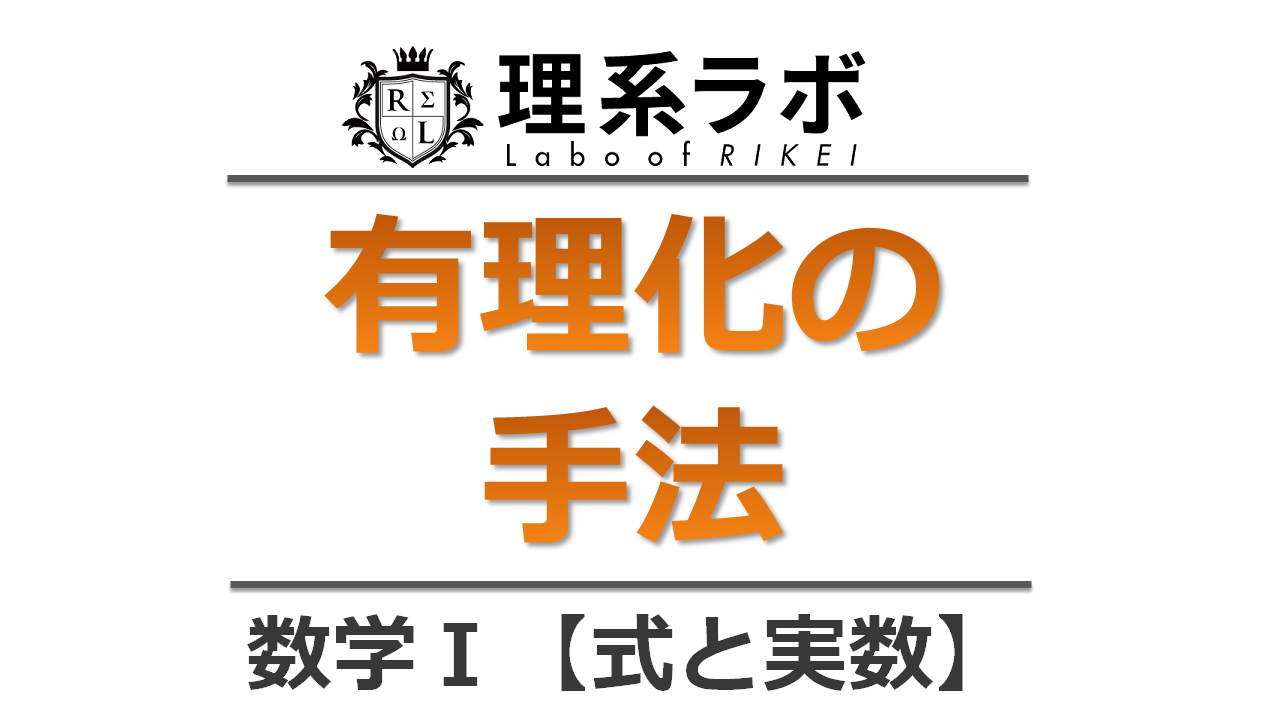
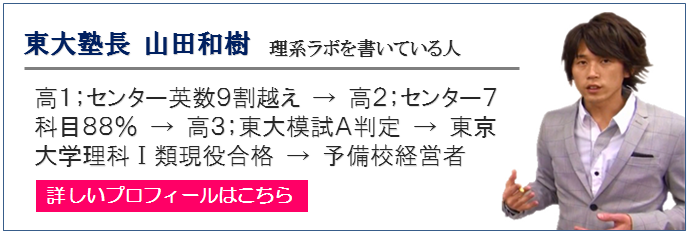
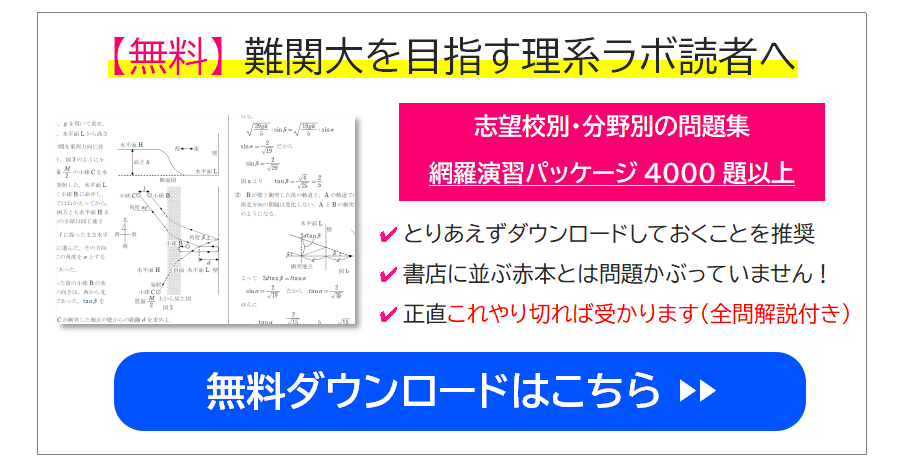


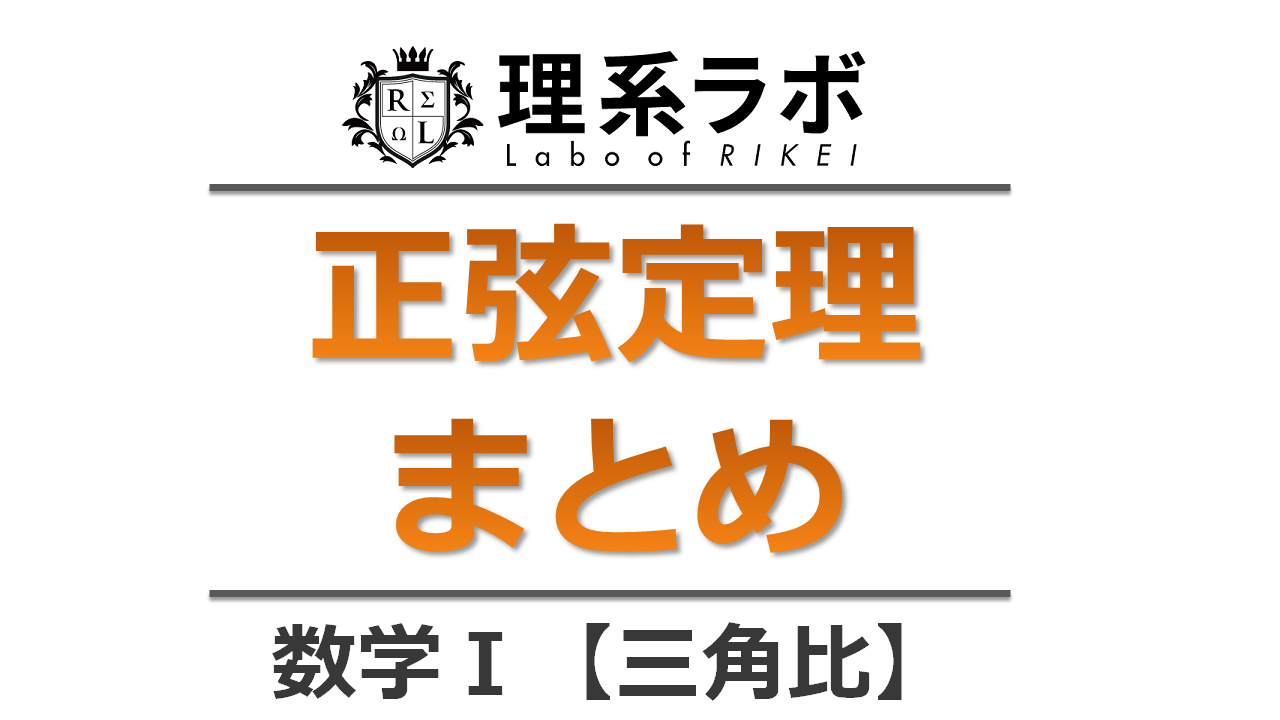
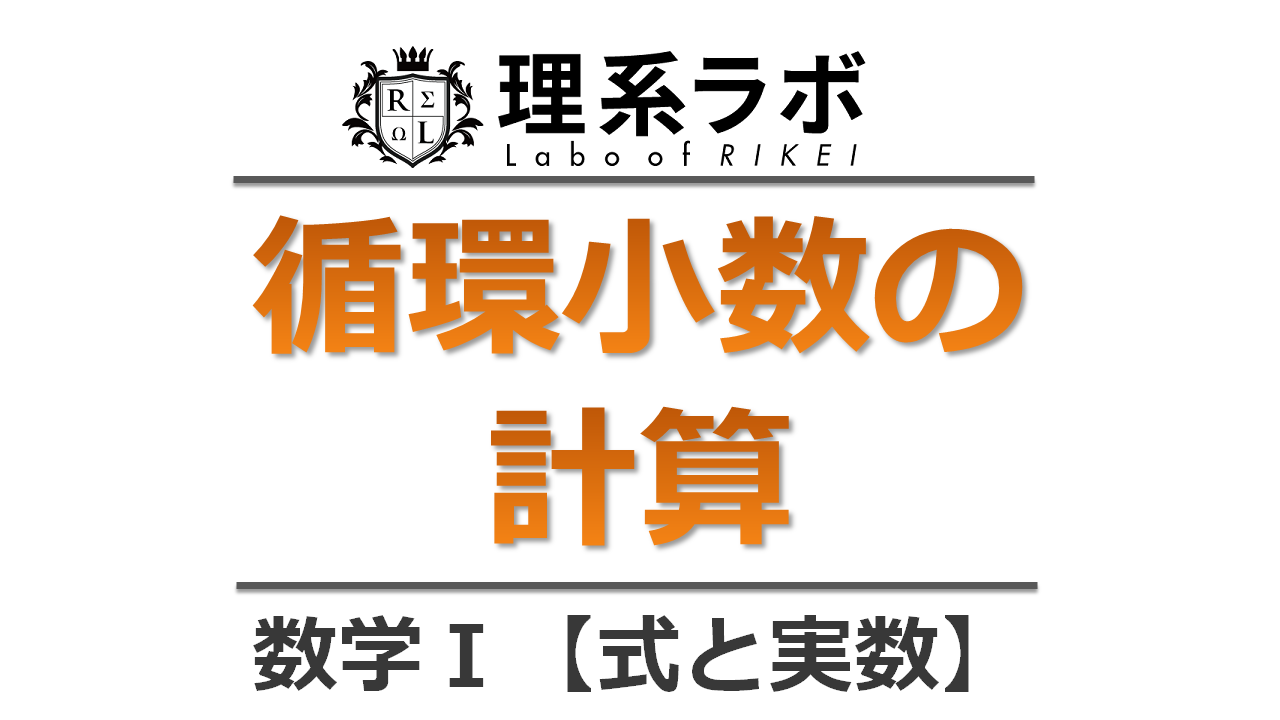

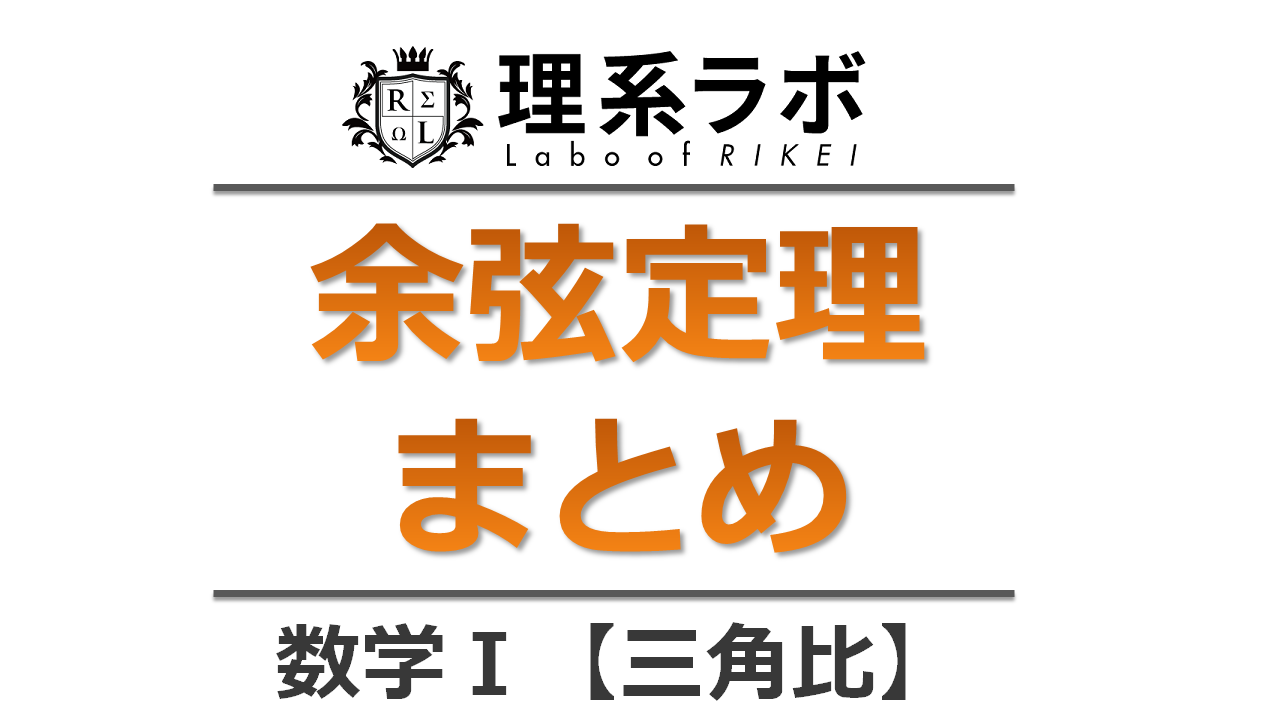
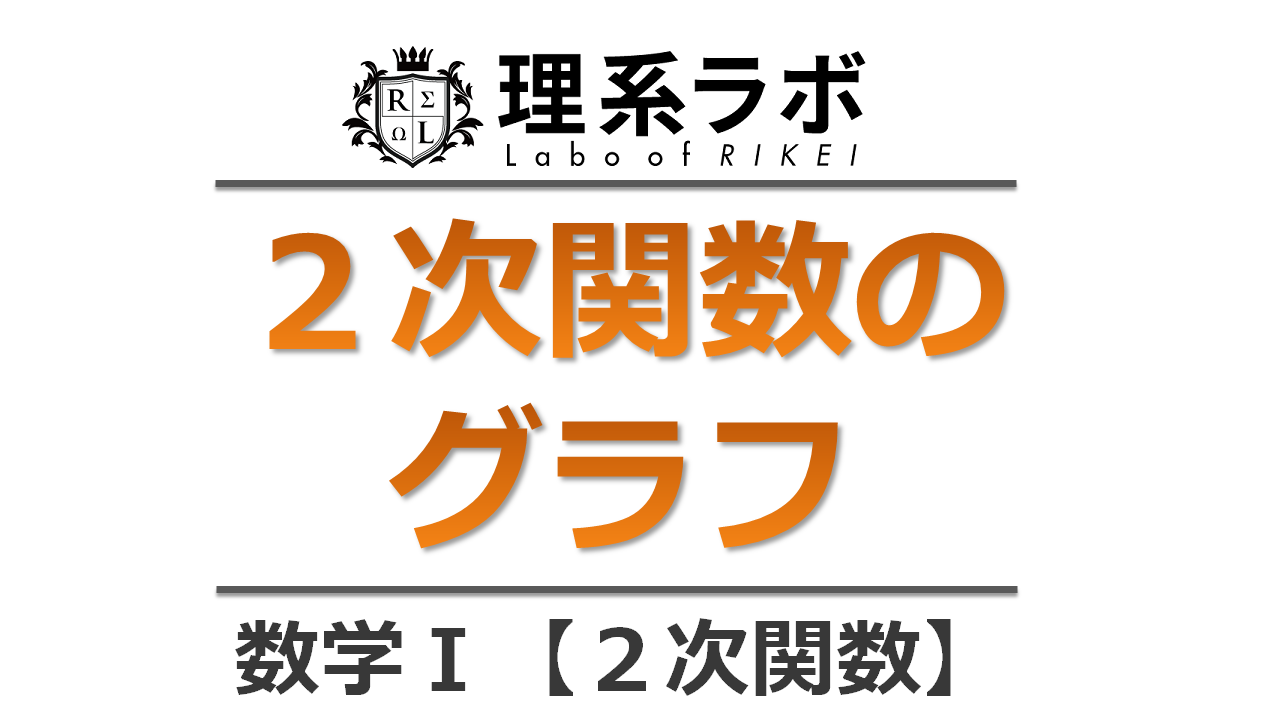
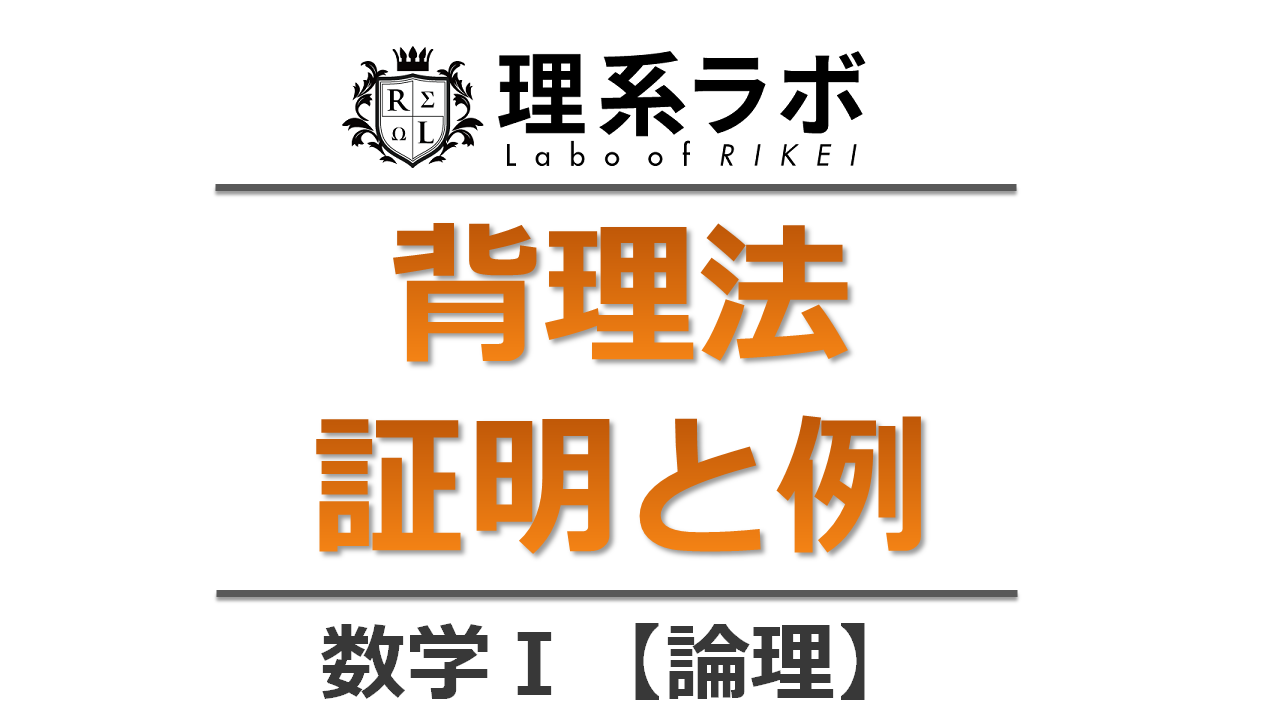
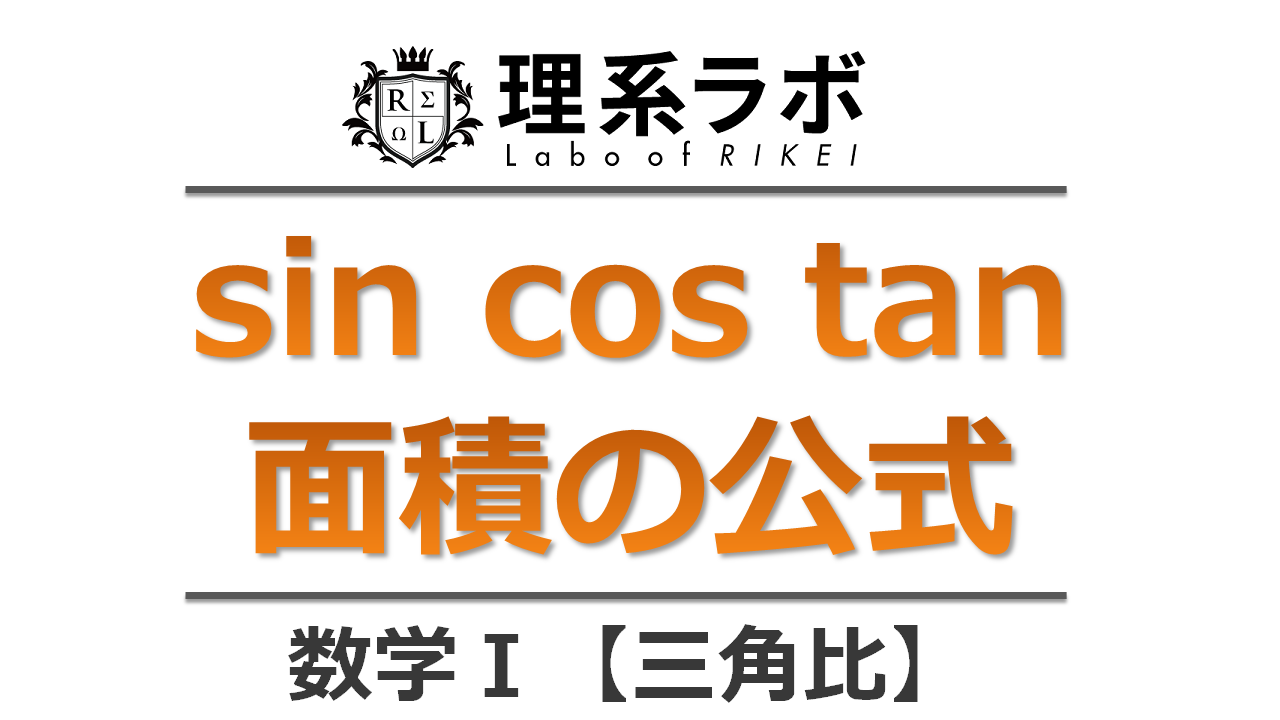


4.2(例題⑩)についての質問です。
有理化に入る前、
(√5−√6+√11)×(√5+√6+√11)
→ {√5-(√6-√11)}×{√5+(√6-√11)} とありますが
×の後半、符号違ってませんか?
a+b+c={a+(b+c)}なので小カッコ内はマイナスにならないです。
これを直した場合、解き方ってどうなるんでしょうか?
> ×の後半、符号違ってませんか?
> a+b+c={a+(b+c)}なので小カッコ内はマイナスにならないです。
×の後半、a-(b+c)の符号がa+(b+c)と違っているのはa+b+c→{a+(b+c)}にしたのではなく、分母に√A+√Bがある時には分母と分子に√A-√Bをかけることで、あえて二乗同士の引き算(A-B)をつくって分母を有理化しようとしているのです。